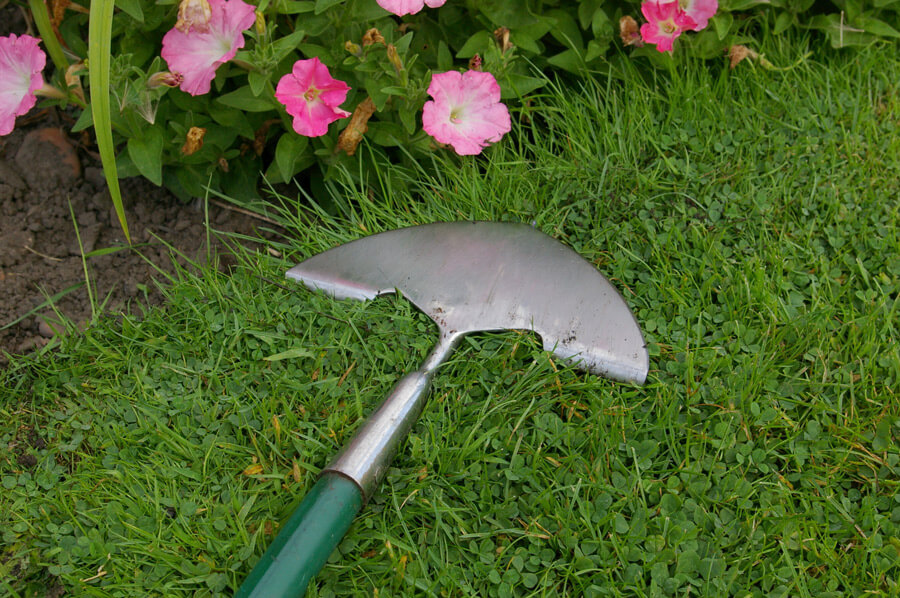What can you do to keep your lawn beautiful all summer long? Here are Robbie’s lawn care tips for July.
Lawn care jobs for July
- Trim those edges: When the edges of your lawn are neat, the whole garden looks magnificent.
- Mowing: Mow mindfully. Aim to reduce any possible weather-related stress on the plants.
- Feeding: Use the right formulation for the time of year and consider supplementing feed with a seaweed tonic for a more vibrant green colour.
- Watering: Established lawns shouldn’t need watering. However, if you want to avoid seasonal browning, it’s best to water really deeply once or twice a week.
- Weed control: This is a great time of year to spot treat any weeds as they appear. Remove weeds by hand if possible, or ask a trained lawn care professional to apply suitable herbicides.
- Pest Control: Worried about leatherjackets or chafer grubs? Apply nematodes as soon as the crane flies and may bugs start getting active…usually late July through to September. Click here to learn about leatherjackets
- Keep moving lawn furniture, ornaments and toys – make sure those plants get lots of sunlight and really good ventilation.
- Enjoy your lawn!

Keeping the edges of your lawn neat will make your whole garden look manicured and loved
The principals of summer lawn care
Summer is a time when we all just want to kick back, relax and soak up some sunshine. And that’s all that your lawn wants to do too.
By July, growth on most lawns in the UK will have slowed down. It’s all part of the natural growth cycle of grass. Take a look at the farmers’ fields. Wheat and barley (both grasses) are at their maximum height. Their seeds are ripening and the foliage is changing colour. In the meadows, if the hay hasn’t already been cut, it soon will be. Once the seed heads have been whisked away, the grass plants will rest for a while before regenerating themselves.
Your lawn is managed in a very different way to agricultural crops. Nevertheless, the plants are from the same family and have the same physiology and life cycle. It’s just that the very clever plant breeders have used selective breeding to produce grass varieties that are hardwearing and beautiful, rather than super-nutritious. When you understand what the grass plants are trying to achieve, you’ll be more successful at lawn care.
Working with nature for great results
Lawn care is always easier if you choose to work with Nature. With experience, you will learn to “read’ your lawn and know exactly what it needs on a week-to-week basis. I’m in Belfast, you might be in Cornwall or Norfolk – we’re probably not experiencing the same weather patterns. Plus we’ll have different soil types and different lawn grass species too. So whilst I’m happy to tell you what I’m up to today – you need to be able to adapt your lawn care regime to suit the conditions where you are.
In an ideal world, each lawn care task you do will be either reactive – providing the plants with what they need now and getting visibly fast results. Or the task will be proactive…anticipating what your plants will need in the next 3 -6 months and improving the soil to meet their needs.
July is all about keeping your lawn neat, trying not to stress the plants when they want to rest, minimising water loss, optimising sunlight, making sure the right nutrients are available when the plants need them, and encouraging roots to travel deep into the soil.
Most importantly of all, July and August should be about enjoying your lawn. After all that hard work in spring, you should feel proud of how it looks and you should relish using it as often as you can.

A word about mowing
From the pictures, videos and comments people are sharing on the Premier Lawns Community Facebook Page, I can see that there are some very mowing aficionados out there. Keeping a lawn in perfect condition all summer long is an art form and can be time consuming. Whether you are a lawn stripe aficionado, or you have a more relaxed approach to summer lawn care, here are a few mowing tips for lawn care in July.
- Keep those mower blades razor sharp. It’s important that you make a clean cut that heals quickly before too much water evaporates from the wound.
- Remove as little of the grass as you possibly can in one go – especially during hot weather. It’s better to cut little and often than to let the lawn grow longer and then scalp it.
- Raise the cutting height. A longer sward will shade the ground and help to retain soil moisture. Nature has designed grass blades to channel rainwater towards the soil – the longer the grass blades, the better they can perform this task.
- Mowing in the evening will also help to reduce water loss through evaporation
- If the grass is dry, it’s OK to let the clippings fly. They’ll provide a mulch as well as nourishing soil microbes.
- Going on holiday? If you come home to find the lawn has grown a lot, remember the one third rule. Reduce the length of the sward gradually.
Other gardening jobs for July
We all need other plants and garden features to help show lawns off to their best advantage. Here are some “rest of the garden” jobs for July.
- Deadhead flowering plants regularly to extend their flowering season
- Keep on top of the weeding. Regular hoeing is great, it will disturb the eggs of slugs and snails.
- Feed flowering plants and vegetables. I like to use tomato feed to encourage lots of blooms
- Hedge trimming. Hedges can be trimmed now PROVIDED there are no birds nesting in them.
- Sow biannual seeds for a vibrant display next spring. It’s time to sow wallflowers, honesty, sweet william and foxgloves.
- Provide a shallow tray of water for hedgehogs and other wild creatures. Add some smooth pebbles to it so that bees can drink without drowning.
Useful Links
You might enjoy some of our other articles on lawn care and gardening in summer….and don’t forget to visit our YouTube Channel for inspirational lawn care tips and advice.
Join the Premier Lawns Community on Facebook
Great garden activities for children
How to encourage butterflies and bees into your garden
